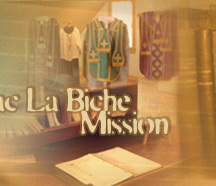Education/Schools/Students | Nuns | Oblates
Alexis Reynard & fellow brothers | Bishop
Grandin and "The Shepherd Boy" | Aves
and Lighted Candles |
Fathers O.M.I | Smallpox
| 20 Years of Missions | Fifty
Years In the Land of Snow | Fifty
Years Part II |
Fifty Years Part III
OBLATES
Alexis Reynard & fellow brothers
This document records the names of a few of the brothers who served at Lac La Biche Mission, and it notes some of their accomplishments.
***
Lay Brother Alexis Reynard, O.M.I.
Row C No.27
 Born
in France, September 28, 1828; murdered near House River (Athabasca), North
West Territories, probably June 20, 1875.
Born
in France, September 28, 1828; murdered near House River (Athabasca), North
West Territories, probably June 20, 1875.
Entered Oblate Order in France, 1850. Professed religious vows for life, 1852.
Sent to Western Canada as missionary-helper. Worked at St. Boniface, Manitoba, Ile-à-la-Crosse, Saskatchewan, 1852-1853.
Transferred to Mackenzie diocese, he worked as handyman at Fort Chipewyan, ten years; Fort providence, also in North West Territories, 1863-1870; Lac-La-Biche, Alberta link between land freight and barge transportation to high North, 1870-1874.
On a trip from Fort Chipewyan to Lac La Biche with an
orphan teenage girl and his Iroquois guide, he was killed and partly eaten
by the latter probably because he protected the girl from the guide.
Buried first in Lac La Biche, then in St. Albert Oblate
plot.
“The blood of martyrs is seed of Christians.”
The Gruesome Death of Brother Alexis Reynard
"Here lie the remains of Brother Alexis, O.M.I., murdered by his Iroquois guide in 1875, R.I.P." – Inscription on the gravestone of Alexis Reynard.
In 1872, Bishop Faraud travelled to Europe to go on a
"begging" mission. He returned to Lac La Biche on July 27, 1875
to a tragedy which shook the community, as the account of the death of Brother
Alexis Reynard in annals of the Oblates of Mary Immaculate reveals. The annals
pick up the story the day after the Bishop's arrival at Notre Dame des Victoires:
"On the day following the arrival at Lac La Biche
of Rt. Rev. Bishop Faraud, a good half-breed, named Thomas Hupe, reached the
mission. ‘Brother Alexis Reynard, where is he?’ was his first
question. ‘If the Brother has not yet returned, then I greatly fear
some misfortune has happened. A month ago we left Lake Athabasca together
to come here, in company with my family and an Iroquois half-breed named Louis
Lafrance. The journey was being made satisfactorily when all at once we found
ourselves confronted by the sudden swelling of the waters in the Athabasca
river.’
‘We had already passed Fort McMurray at some considerable
distance, when we realized that it was impossible for us to row our way up
stream in our canoes. Our provisions, alas, were so reduced that we were quite
unable to make for our destination at Lac La Biche. Then,’ said I to
Brother Alexis, ‘We have nothing else to do but to retrace our steps
to Fort McMurray and wait there till the river returns to its normal height.
We can then obtain the necessary supply of provisions from the Hudson's Bay
Company, and we shall then be able straightway to ascend the stream again
in safety.’
‘But Brother Alexis replied: Bishop Faraud is waiting
for me at Lake La Biche to construct the boats that are absolutely necessary
for the transport of the supplies indispensable for his mission. I must at
all cost arrive at the appointed time, otherwise all the missions of the north
will be in suspense and deprived of their needful supplies. Return with your
family to Fort McMurray while I and my guide, Louis the Iroquois, will go
by land to Lac La Biche. We will live as best we can by our guns and, after
six or seven days march across the forest, we shall arrive at the mission.’
‘My wife and I,’ added Thomas Hupe, ‘returned
to Fort McMurray. It is now three weeks since Brother Alexis and his guide
left us, and they ought to have been here fifteen days ago. Since they have
not arrived I can only conclude that some misfortune has occurred.’
The following day, two half-breeds engaged by Father
Leduc, left Lac La Biche to go to the relief of the missing Brother and the
guide. Twelve days later they returned, arriving at the mission at four o'clock
in the morning.
‘I have found your Brother,’ said one of
them. ‘He is buried under a slight covering of sand at the entrance
of the mouth of the House River into the Athabasca river, and what is very
extraordinary,’ added the man, ‘the bones were already fleshless,
but I recognized the Brother easily by his beard and his hair.’
Brother Alexander Lambert immediately set out with a
canoe and four men to discover the remains of our poor Brother. [They] Arrived
at the spot that had been pointed out to them, they were proceeding to exhume
the dead body, when, to their horror, they found only dried bones, scattered
pell mell, while many were completely missing. None of them bore the marks
of an animal's teeth, but they had been chopped in various places, apparently
by the axe that was found by the side of the body, bearing the stains of blood.
The victim's head was pierced through and through. There was no doubt but
that Brother Reynard had been killed and the charred bones found at some paces
from the spot gave indication that he had served the purpose of appeasing
the hunger of his Iroquois guide.
The scattered remains were gathered together by Brother
Lambert with deep respect and unspeakable emotion. Twenty days afterwards,
we gave reverent burial to these dear remains after I had examined them myself
and had ascertained the identity of the Brother by the inspection of his hair
and his beard which had been left intact. A shoulder blade was missing. We
learnt that it had been found later in the forest, a day's march from the
scene of the crime.
The murderer had been forced to satiate his hunger on
the spot. Then, doubtless, he had stripped the flesh off the bones and carried
away as much of it as he was able, after having first dried it after the manner
the Indians on the prairie dry the flesh of the buffalo. Had the wretched
guide himself finally to succumb to his fate? We may well forecast, for he
has neither been seen nor heard of since.
Brother Alexis Reynard had labored for more than
twenty years in missions of the North with unstinting devotedness. He was
always the model of a perfect Religious. His death was terrible from a natural
viewpoint, but God will have received His faithful servant, to be Himself
his eternal recompense."
Lay Brother Anthony Kowalczyk, O.M.I.
Row 8 No. 6
Born in Poland, June 4, 1866; died in Edmonton, Alberta,
July 10, 1947.
Entered Oblate Order at St. Gerlach, in Holland, October
1, 1891.
After four years with Dutch Oblates, he was designated
for South African missions, but a last minute change diverted him to Western
Canada, 1896. He professed his religious vows for life January 17, 1898, in
St. Albert.
He worked as handyman in Lac La Biche, Alberta mission,
1896-97, where a serious accident caused the amputation of his right arm below
the elbow, July 15, 1897.
Notwithstanding this loss, Brother Anthony, as he was
called, worked as handyman and farmer at St. Paul, Alberta Métis Colony,
1897-1911.
Transferred to new-born St. John College, Edmonton, Alberta,
1911, he worked as furnace-man, gardener, toilet-cleaner, laundry-man, skate-sharpener...
until his death in 1947.
His devotion to the Blessed Mary is legendary: he taught
all us boys to say, not ‘Thank You’ but ‘Ave Maria’.
His example and prayers for the teenage boys who passed through St. John College
made it a cradle of hundreds of Oblate vocations to the priesthood and as
&#brothers’ from Western Canada.
His reputation of holiness is expected to be soon
officially recognized by the Church. Ave Maria.
Lay Brother Albert Côté, O.M.I.
Row A No. 24
Born in Québec, March 29, 1905; died in St. Albert,
Alberta, January 16, 1978.
Entered Oblate Order in Québec, 1935. Religious
vows for life in Lac-la-Biche, Alberta, 1942.
Zealous lay-helper, mostly as farmer and jack-of-all-trades in Lac La Biche mission and school, 1936-1951 and 1959-1964; in St. Albert and Lac St. Anne, 1954-1959; 1964-1969.
He served crippled Father A. Poulin, O.M.l. in Brocket,
1969, as cook and nurse.
Retired to Foyer Grandin, 1969, Oblate home for
seniors, where he died suddenly, 1978.
Lay Brother Patrick Bowes, O.M.I.
Row D No. 26
Born in Kingston, Ontario, July 23, 1830; died in St.
Albert, Alberta, March 9, 1908.
Patrick entered Oblate Order in Bytown (Ottawa), 1851.
Final religious vows in Île-à-la-Crosse, Saskatchewan, 1856.
Sent to Western Canada as master-carpenter. He built at Île-à-la-Crosse four times, 1855-1869; also four times in Lac La Biche, Alberta, 1857-1865.
In St. Albert, he built the (second) cathedral, 1869,
which burned in 1921, and moved the flour-mill from "between the two
bridges in St. Albert", 18 miles down river, near Lamoureux, opposite
Fort Saskatchewan, Alberta, in 1869-71.
He built missions in MacLeod, Hobbema, Dunbow, 1881-1882; 1884. His specialty led him to Edmonton, 1889, Calgary, St. Albert, 1889-1890. To Lethbridge, 1891, Canmore, 1893, Banff and Cochrane, 1894; all in southern Alberta. To Lac La Biche, 1895-1896; Saddle Lake, 1896-1906; and finally St. Albert, 1906-1908.
The great carpenter-apostle died at the ripe old
age of 78.
© 2003 Société
culturelle Mamowapik and the Lac La Biche Mission Historical
Society (All Rights Reserved)






